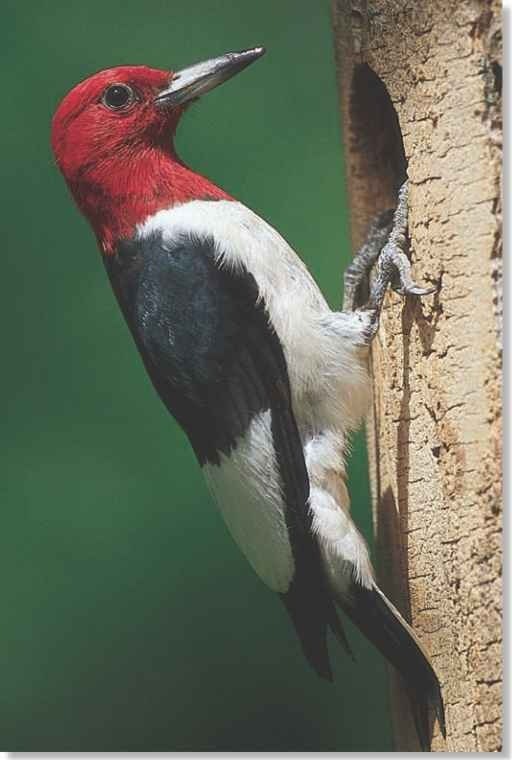ORDER
Piciformes
FAMILY
Picidae
GENUS & SPECIES
KEY FEATURES
• Its brilliant red
head makes this bird conspicuous no matter i where it flies or lands
• Uses its hard, pointed bill to drill into trees in search of food and nesting sites
• Has a voracious appetite; almost anything is game for this active woodpecker
• Dwells in open country where dead trees are plentiful
WHERE IN THE WORLD?
Occurs in North America from Canada’s Lake Winnepeg and southern Ontario south to the Gulf of Mexico and Florida; east of the Rocky Mountains and west of New England
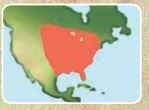
Lifecycle
Migratory flocks of red-headed woodpeckers color the sky with a spectacular display of crimson; their bright heads are equally visible while drilling from their tree-side perches.
HABITAT
With a preference for open country, the red-headed woodpecker frequents mature lowland forests with plenty of dead trees for nesting and open undergrowth. Other habitats include various types of wooded savannahs, open woodland, pine forests, villages, suburbs, orchards and agricultural lands. Southern populations may choose clearings with tall stumps. In the post-breeding season, the woodpecker will flock to tall mature woodland. Northern populations will migrate south regularly from August to November, and winter in Kansas, Iowa, Ohio and New Jersey in search of new food sources. The woodpeckers return north in March.
Garden post
An adult uses its tail for support while perching.
Youthful yearning A drably-colored juvenile perches in a fruit tree.
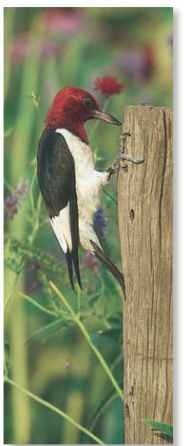
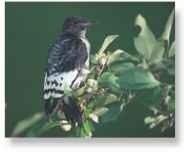
CONSERVATION
Red-headed woodpecker numbers are plentiful in North America, and there is no immediate danger to the bird, other than destruction of its preferred woodland habitats.
FOOD & FEEDING
The omnivorous woodpecker forages in trees and on the ground, feeding on anything from small birds, bird eggs and mice to insects, fruits and seeds. Its wide range of prey also includes earthworms, crickets and wasps. After pecking away at dead tree bark, the bird uses its long tongue to extract insects, including beetle larvae. For larger animal prey, such as mice, the bird pounces on its victim and pecks it with its bill. Besides the nuts and acorns the woodpecker stores in winter, the bird also has caches of various fruits, including cherries, grapes and apples.
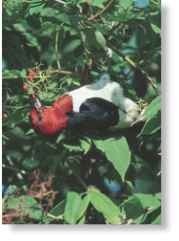
A Hold on tight An adult grasps a branch with its strong toes while hanging upside down to reach some berries.
BUSY FEEDER
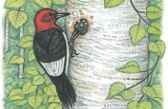
Bird at work…
A woodpecker discovers a nest and chisels away until the hole is wide enough for the bird to look for any resident nestlings.
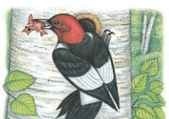
Reach and grab…
A young chick doesn’t stand a chance as the woodpecker plucks it from its nest and flees the scene of the ambush.
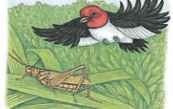
Grasshoppers galore…
The unsuspecting grasshopper, a favorite food among woodpeckers, does not see the swooping bird that will make a meal of the insect.

Mission over
The woodpecker stores the grasshopper in a crevice along with dead beetles and other insects it has captured for future food sources.
BEHAVIOR
The red-headed woodpecker will use anything hollow, such as a tree trunk as a drum to sound warnings to defend its territory. The bird repeatedly bangs away with its strong, sharply-pointed bill, pecking holes along the way. The woodpecker also emits rapid churr calls when it defends its range. The woodpecker is so aggressive that it will chase away most other bird species. During short-distance migrations, redheaded woodpeckers travel in flocks of several hundred birds, displaying a unique bobbing style of flight in which the bird appears to rise and fall several times.
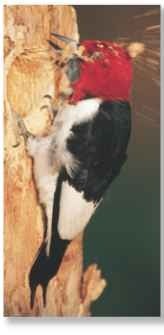
Flying chips A red-headed woodpecker chisels a nesting cavity in a tree with rapid drilling motions of its sharp, pointed bill.
The red-headed woodpecker will suspend the wing-molting process when it is time to migrate and will continue it after arriving at its wintering grounds.
One persistent female laid 32 eggs in a season before successfully raising a brood.__
BREEDING
During the breeding season, from April to August, the male redheaded woodpecker will excavate the nesting site, a cavity 8-24″ deep, 5-80′ above ground, usually in a cypress, oak or palmetto tree. Woodpeckers, which are not too finicky, will also use nest holes in buildings and other artificial structures, including common fence posts and even broken wagon wheels, as long as the entrance hole is about 1.75″ in diameter: Drumming is part of the courtship ritual, and pairs will often perform mutual tapping, with one bird inside the hole of a tree and the other at the entrance. The male is monogamous; however; occasionally another female will join the pair to help care for the brood.The female will lay 4-7 white, glossy eggs on a layer of fine wood chips, and both sexes will incubate the eggs for 12-13 days.
The helpless chicks are naked and blind with extremely long necks — longerthan their bodies, in fact. Both parents will feed and care for the hatchlings until they are ready to leave the nest, within 30 days, and after their juvenile plumage has developed.The pair will usually produce a second brood a short time later at a different location. If the eggs are taken or destroyed, the persistent pair will produce more.
► Fresh food A parent brings a protein-rich insect meal to its hungry chicks.
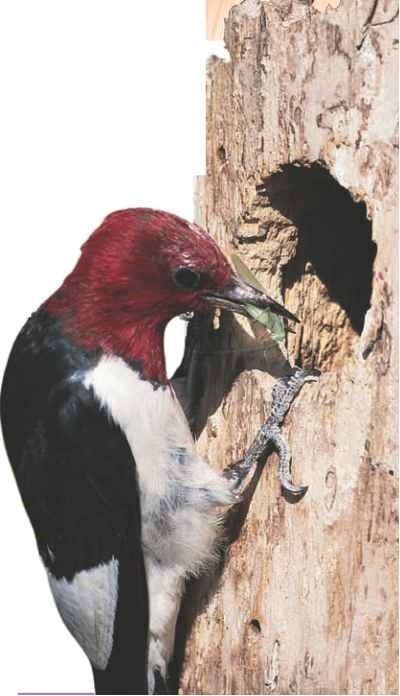
PROFILE
Red-headed Woodpecker
The handsome red-headed woodpecker flashes its signature crimson head as it flies to a handy perch on dead or fallen trees.
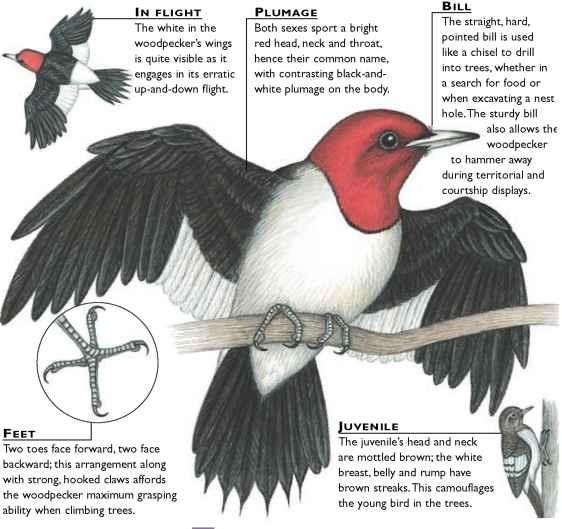
CREATURE COMPARISONS
The acorn woodpecker (Melanerpes formicivorus) at 9″ is the same size as its red-headed cousin and prefers to live close to oak trees and woodlands in western North America south to Colombia.The sociable acorn woodpecker lives in groups of up to 12 birds that defend a shared territory and nest communally, while the redheaded woodpecker usually nests in separate pairs. In late summer, the acorn woodpecker bores holes into trees, fences and wooden buildings, storing an acorn in each hole, which serves as a future food site. The acorn woodpecker’s plumage differs from the red-headed species; its head is only partially red, with black-and-white markings.
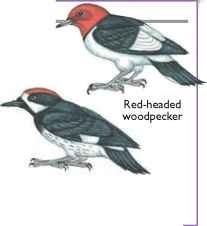
Acorn woodpecker
| VITAL Weight |
STATISTIC 2-3.4 oz. |
| Length | 7.5-9″ |
| Wingspan | 16-18″ |
| Sexual Maturity | 1 year |
| Breeding Season | April — September |
| Number of Eggs | 4-7 |
| Incubation Period | 12-13 days |
| Fledging Period | 27-30 days |
| Breeding Interval | Usually 1 or 2 broods per season |
| Typical Diet | Nuts, seeds, insects and fruit |
| Lifespan | Over 10 years |
RELATED SPECIES
• The red-headed . woodpecker is one of 22 species in the genus Melanerpes, including the golden-fronted woodpecker, M. aurifrons, with its “zebra-striped” coloration. There are about 200 species of woodpecker, wryneck and piculet in the family Picidae. The family includes the red-breasted sapsucker, Sphyrapicus varius, and the northern flicker, Colaptes auratus.
